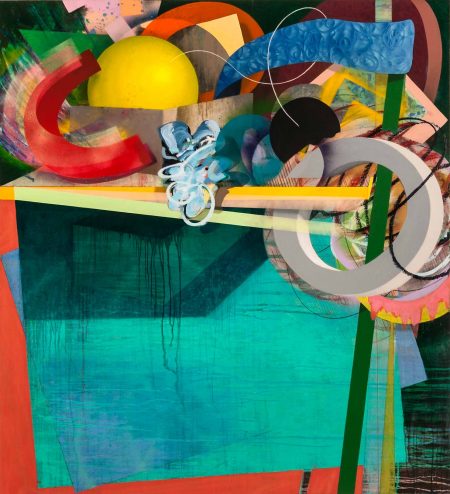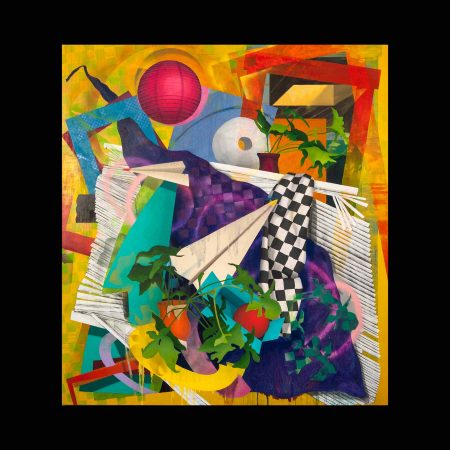“Nothing seems that certain”1 is a great operating procedure for an artist to generate new work. This is what Kim Krause believes and it is clearly manifested in his new solo exhibition at Marta Hewett Gallery titled The Nature of Things. Krause read the original long poem De rerum natura (On the Nature of Things)2 written 2,000 years ago by Roman poet Lucretius, which inspired Krause to explore the tradition of the still life as he might fold it into his oeuvre, given all his years as an abstract painter.
Any number of things or encounters can cause a seismic shift in an artist’s career. For artist Wassily Kandinsky, an encounter with a Monet “Haystack” painting changed everything for him: “the way the worldly forms dissolved into a blaze of color.” Monet painted his mesmerizing haystacks in the late 1880’s and Kandinsky saw one in 1896, abandoned his career as a lawyer and moved to Munich to study art. Kandinsky is one of the seminal early painters who moved swiftly into abstraction. So Krause’s shift to embrace the tangible – things, still lifes – in his new paintings is not so shocking. Krause is a Cincinnati native so his work, primarily abstract, is familiar to the local art audience. In interview, Krause discussed with me that his dedication to abstraction spanned twenty years.
But after twenty years, he began to search for something different, or in his words, something more specific. In reading De rerum natura, Krause began to explore what things existed in his personal world. So the still life emerged as a central compositional device to explore what is before him. Anyone who has a studio can recognize the scraggly plants featured in a few of his new oil paintings. But what else? I asked the artist about the ellipses, disks and rings he puts in most of his new paintings. Here something lovely and personal comes in, an abstract form that is for him an important symbol. Sorry, I’m not divulging. I think those sweet personal hooks to keep an artist going all day in a cold or lonely studio are important. You may ask Krause to discuss/decode various abstract forms to find out for yourself. Consciously or better yet unconsciously, wonderful forms, colors and textures can emerge in a painting as an artist works through his/her thoughts, emotions and ideas.
So Krause’s circles, rings and ellipses function emotionally for him in some cases and they function optically and spatially too. Krause points out that if he puts both a circle and an ellipse in a painting, the ellipse is usually read or perceived as a circle moving backward or forward in space. Krause certainly likes that implied movement; it’s all over his paintings. He creates optical movement with ribbons, swaths of striped or checked fabric also. These patterned fragments are more distracting than appealing. Krause uses enough beautiful painting techniques and tropes; he doesn’t need these eye-popping, shopworn devices. It’s good to keep trying different elements, but some aren’t needed anymore in his vocabulary.
As to his various techniques, Krause shared that he got interested in adding spray paint some years back through his own teen-aged son’s use of spray paint for graffiti work. Sprayed areas of the paintings add visual delight and a hint of mystery to The Nature of Things series. The best painting in this solo exhibit is The Nature of Things #11. In it, tiny white stars are spray painted within a perfect blue sky. Plant fronds are spray painted rising from a dark cubist-like tabletop. More ghostlike plant fronds rise upward, as if we are seeing a frame of trees outside the window of the studio. It’s pretty Mediterranean in feel, with so much of the painting swathed in blue, clearly a mental place where Kim Krause has been (given his previous Eleusinian Mysteries series of paintings.) There is, finally, a dynamic white arc, like the path of a shooting star, cutting across the painting. Painting #11 calls to mind Cubism and Orphism and, because of faint spray paint elements, intentional AbEx drips and some barely perceptible lines made with pencil, offers a fresh feel of the Now.
The Nature of Things #15 is one of Krause’s numerous experiments with ‘things’ and it is too busy, too packed with things. West Coaster Lari Pittman can pack his large tableaux paintings with a dizzying array of things, but Pittman has a really large lexicon of forms and symbols that he repeats in varied scale and to ramp up the spooky dynamism of his paintings. Not to mention his use of the erotic symbols used by the once marginalized gay community. Jane Hammond is another artist who packs her paintings and prints with a large number of repeated forms, illustrations and symbols. Pittman and Hammond use a wide range of repeatable forms and juggle meaning with them. For Pittman, a 19th century silhouette creates a feeling of history and also alludes to a ‘dandy.’ People with long memories will recall that in 1993, the Cincinnati Art Museum organized the first museum exhibition for Jane Hammond3. I think Krause is on a rich lode of discovery as he continues to advance his use of ‘things’ that having meaning to him and that can continue to make his colorful paintings vibrate emotionally as they do optically.
It is also important to point out when artists give back. Krause was co-founder of the Over-the-Rhine Chamber of Commerce and Chairman of the Over-the-Rhine Design Studies Project. He was instrumental in having Over-the-Rhine declared a National Historic Neighborhood. He is currently a professor of Art at the Art Academy of Cincinnati and Academic Dean.
–Cynthia M. Kukla is an artist and Professor Emerita of Art living in Cincinnati.
Photographs provided by artist and Marta Hewett Gallery.
1Kim Kraus phone interview quote, November 2017. “Nothing seems that certain”1
2De rerum natura (On the Nature of Things) Lucretius presents the principles of atomism; the nature of the mind and soul; explanations of sensation and thought; the development of the world and its phenomena; and explains a variety of celestial and terrestrial phenomena.
3Jane Hammond was featured for her first solo museum exhibit at the Cincinnati Art Museum, as noted in Cincinnati Magazine, November, 1993







November 28th, 2017at 1:26 pm(#)
Nature of Things #11 and #7 by Krause both have spaces that are calming and quiet, whereas #15 does not. This makes #11 and #7 easier for the eye of the viewer to enjoy and study. I agree with the author that #15 is too busy, especially since it lacks a calming space as counterpoint to the very busy space.